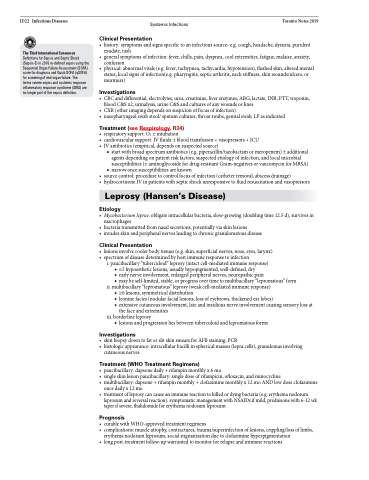Page 622 - TNFlipTest
P. 622
ID22 Infectious Diseases
Systemic Infections Toronto Notes 2019
Clinical Presentation
• history:symptomsandsignsspecifictoaninfectioussource-e.g.cough,headache,dysuria,purulent exudate, rash
• generalsymptomsofinfection:fever,chills,pain,dyspnea,coolextremities,fatigue,malaise,anxiety, confusion
• physical:abnormalvitals(e.g.fever,tachypnea,tachycardia,hypotension),flushedskin,alteredmental status, local signs of infection(e.g. pharyngitis, septic arthritis, neck stiffness, skin wounds/ulcers, or murmurs)
Investigations
• CBCanddifferential,electrolytes,urea,creatinine,liverenzymes,ABG,lactate,INR,PTT,troponin, blood C&S x2, urinalysis, urine C&S and cultures of any wounds or lines
• CXR(otherimagingdependsonsuspicionoffocusofinfection)
• nasopharyngealswabstool/sputumcultures,throatswabs,genitalswab,LPasindicated
Treatment (see Respirology, R34)
• respiratory support: O2 ± intubation
• cardiovascularsupport:IVfluids±bloodtransfusion+vasopressors+ICU • IVantibiotics(empirical,dependsonsuspectedsource)
■ start with broad spectrum antibiotics (e.g. piperacillin/tazobactam or meropenem) ± additional agents depending on patient risk factors, suspected etiology of infection, and local microbial susceptibilities (± aminoglycoside for drug-resistant Gram-negatives or vancomycin for MRSA)
■ narrow once susceptibilities are known
• sourcecontrol:proceduretocontrolfocusofinfection(catheterremoval,abscessdrainage)
• hydrocortisoneIVinpatientswithsepticshockunresponsivetofluidresuscitationandvasopressors
Leprosy (Hansen’s Disease)
Etiology
• Mycobacteriumleprae:obligateintracellularbacteria,slow-growing(doublingtime12.5d),survivesin macrophages
• bacteriatransmittedfromnasalsecretions,potentiallyviaskinlesions
• invadesskinandperipheralnervesleadingtochronicgranulomatousdisease
Clinical Presentation
• lesionsinvolvecoolerbodytissues(e.g.skin,superficialnerves,nose,eyes,larynx) • spectrumofdiseasedeterminedbyhostimmuneresponsetoinfection
i. paucibacillary “tuberculoid” leprosy (intact cell-mediated immune response)
◆ ≤5 hypoesthetic lesions, usually hypopigmented, well-defined, dry
◆ early nerve involvement, enlarged peripheral nerves, neuropathic pain
◆ may be self-limited, stable, or progress over time to multibacillary “lepromatous” form
ii. multibacillary “lepromatous” leprosy (weak cell-mediated immune response)
◆ ≥6 lesions, symmetrical distribution
◆ leonine facies (nodular facial lesions, loss of eyebrows, thickened ear lobes)
◆ extensive cutaneous involvement, late and insidious nerve involvement causing sensory loss at
the face and extremities iii. borderline leprosy
◆ lesions and progression lies between tuberculoid and lepromatous forms
Investigations
• skinbiopsydowntofatorslitskinsmearsforAFBstaining,PCR
• histologicappearance:intracellularbacilliinsphericalmasses(lepracells),granulomasinvolving
cutaneous nerves
Treatment (WHO Treatment Regimens)
• paucibacillary:dapsonedaily+rifampinmonthlyx6mo
• singleskinlesionpaucibacillary:singledoseofrifampicin,ofloxacin,andminocycline
• multibacillary:dapsone+rifampinmonthly+clofaziminemonthlyx12moANDlowdoseclofazimine
once daily x 12 mo
• treatmentofleprosycancauseanimmunereactiontokilledordyingbacteria(e.g.erythemanodosum
leprosum and reversal reaction): symptomatic management with NSAIDs if mild, prednisone with 6-12 wk taper if severe; thalidomide for erythema nodosum leprosum
Prognosis
• curablewithWHO-approvedtreatmentregimens
• complications:muscleatrophy,contractures,trauma/superinfectionoflesions,crippling/lossoflimbs,
erythema nodosum leprosum, social stigmatization due to clofazimine hyperpigmentation
• longpost-treatmentfollow-upwarrantedtomonitorforrelapseandimmunereactions
The Third International Consensus
Definitions for Sepsis and Septic Shock (Sepsis-3) in 2016 re-defined sepsis using the Sequential Organ Failure Assessment (SOFA) score for diagnosis and Quick-SOFA (qSOFA) for screening of end-organ failure. The
terms severe sepsis and systemic response inflammatory response syndrome (SIRS) are no longer part of the sepsis definition.


